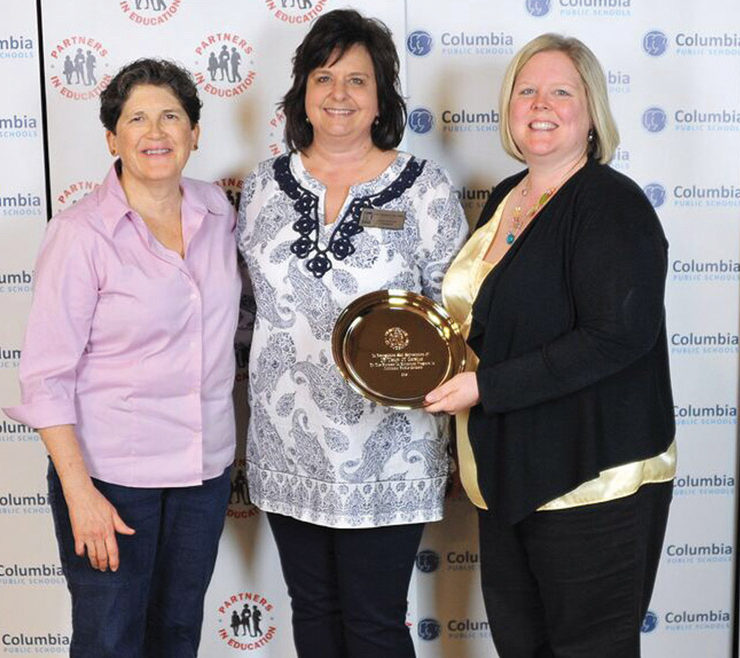Moving On, Moving Up
When it comes to building the right team, the banking industry can look a bit like a Major League Baseball roster. There are different players with varying skillsets working together for the win, and team loyalty often runs deep. But not all players are lifers, and sometimes switching teams is the best career move. Sure, there are those who stay put for the long haul, but more often than not, trades are just part of the game. And when a big-name player leaves one team, you can rest assured they’ll be picked up by another.
When Andrew Beverly was promoted to commercial banking executive for Landmark Bank, his former position as president of the Columbia market was left vacant. Then in October, Landmark hired Matt Williams, the former Columbia president of Hawthorn Bank, to fill the vacancy. Enter Kathleen Bruegenhemke as Hawthorn Bank’s Columbia president. And the local banking industry continued to put its rosters back together again.
According to Compdata Surveys, a national compensation survey firm, the banking industry has the second-highest turnover of all industries at 17.2 percent, compared to 15.1 percent across the board. However, despite dust settling from a recent high-level shakeup, Columbia’s banks seem bent to buck the trend.
“There has been some recent top-tier changes in the Columbia banking market, and transition is oftentimes positive for everyone involved,” Bruegenhemke says. “As upper-level vacancies are created, opportunities to assume new and different responsibilities create positive excitement internally for employees considering their own career paths.”
Although Boone County National Bank pays close attention to changes within the local market, Melody Marcks, director of human resources, says she hasn’t seen many people leave the bank. Every November, the bank celebrates employee anniversaries, and in 2014 it celebrated one 40-year anniversary and two 35-year anniversaries, among other milestones.
Like most banks, Boone County National Bank differentiates turnover between entry-level and advanced positions, Marcks says.
“For entry-level positions like tellers and at the call center, we see and expect higher turnover than after someone has moved beyond that point,” she says.
To cut down on teller turnover, The Bank of Missouri tries to hire tellers in their sophomore year of college to have three years with those students before they graduate. Although they can be placed at any branch throughout Missouri, they often receive degrees in unrelated fields or dream to move to a larger city.
“They always have the option to stay,” says Mary Ropp, senior vice president of business development. In addition to placement, training and opportunities for advancement are also important.
Boone County National Bank relies on its strong training program to help retain workers. “There are two employees totally dedicated to training, and each department has its own trainers that understand what those new people are going through, and that helps both types of turnover,” Marcks says, a sentiment Bruegenhemke shares.
“As employees are upskilled, they generally are more stable team members,” Bruegenhemke says.
The Bank of Missouri says its employees are also motivated to stay by its employee stock options. “When you’re the owner, everything you do you have a personal stake in it,” she says. “That just kind of makes you act differently.”
Since opening in 2004, almost all of The Bank of Missouri’s “skeleton crew” of six employees who first opened the bank still work there. Since then, its Columbia branch has grown to employ 25 people.
Because of the branch’s growth, The Bank of Missouri’s vacancies are often due to promotions and general expansion. “We need more lenders, more bankers, more everything,” Ropp says. “The only other thing we don’t have enough of is desks. It’s really hard to explain our spirit. … People want to be a part of something bigger than themselves. We’re talking to businesses with ideas and concepts and helping them make those a reality. To be a part of that, that’s fun.”
For Boone County National Bank, that extra element to keep turnover low is longevity.
“We’ve been here so long, over 150 years, we have a great longevity of families within our customer base,” Marcks says. “Our commercial lenders have worked with customers forever, so there’s a lot of synergy there.
“We have confidence that we’ll at least get the opportunity to talk to folks if they’re approached by other banks, but we don’t see that very often,” she continues. “On any given day, you don’t know what will happen. You just try to treat people with respect, and that seems to work.”
The Top Tier of Columbia’s Banking Industry
Hawthorn Bank
For Hawthorn Bank, which opened its branch office in Columbia in 2007, significant changes have taken place within the past few months in regard to the bank’s administrative team and its advisory board. Columbia Regional President Matt Williams accepted a position at Landmark Bank, and after 20 years at Hawthorn’s corporate office in Jefferson City, Kathleen Bruegenhemke was promoted to president of the Columbia market. At the same time, Rob Patrick came onboard as assistant vice president, commercial loan officer, and David Clithero joined the bank as vice president of relationship management. Before coming to Hawthorn, Patrick worked at Boone County National Bank. As a previous owner and operator of five Branson entertainment businesses, he brings a unique understanding of the small-business loan process to the administrative team. Clithero served as associate vice chancellor of development at the University of Missouri. “David is helping us on the customer development side of the bank,” Bruegenhemke says. “We have over $100 million in assets with less than that in deposits. We naturally want to grow both our loan and deposit balances, and David will be a tremendous help in that regard.”
Landmark Bank
Headquartered in Columbia, Landmark Bank has operated as a national bank at the same location on Broadway for almost 150 years. Today, it has 42 bank locations in 28 different communities in Missouri, Oklahoma and Texas and is the second largest bank in Columbia in terms of deposits. “Our approach is very much a community banking model,” says Andrew Beverley, who was promoted to the position of Landmark’s commercial banking executive last fall after serving as president of the Columbia bank. “We have local bank presidents in the markets we serve. The presidents of those local banks report to me through regional presidents.” Matt Williams, former president of the Columbia branch of Hawthorn Bank, was hired as Landmark’s Columbia president in October.
Beverley says Landmark also offers stability in a changing market with the Landrum family, who has been in Missouri banking for 100 years, serving as the major shareholders. “It doesn’t matter how much the industry changes and how much the regulations increase; our plan is to stick to the basics of responsive customer service and good, sound banking practices that have served us well for 150 years,” Beverley says.
Commerce Bank
With more than 200 branches in Missouri, Kansas, Illinois, Oklahoma and Colorado, Commerce Bank, which also has commercial offices in Cincinnati, Nashville and Dallas, is the largest bank in Missouri. Commerce has $23 billion in assets on the bank side and more than $37 billion under management in The Commerce Trust Co.
As of January of this year, Lyle Johnson, former vice president of commercial lending, was promoted to market executive for The Commerce Trust Co. in the central Missouri region, which includes Columbia, Moberly, Mexico and Moniteau County. Johnson takes over part of Ryan Lovill’s job. Lovill, who served as market executive for central Missouri and also as portfolio manager, is now portfolio manager.
“Commercial lending is about building relationships and getting to know the customers, how the company operates, but this also involves getting to know the owners so there is a trust and comfort level,” says Johnson, who has worked for Commerce Bank for more than seven years. “I was asked to take over Commerce Trust because I have a natural tendency for developing relationships, and I made a lot of referrals of clients over to this department when I was in commercial lending.”
Boone County National Bank
With 10 locations in Columbia and six branches in the neighboring communities of Ashland, Hallsville, Sturgeon, Centralia and Boonville, Boone County National Bank is smaller than many of its competitors. However, the bank is a market leader, capturing around 40 percent of the local market.
But according to Mary Wilkerson, senior vice president of marketing, their size is an advantage. “As a smaller bank we can customize our services,” she says. “We have to follow certain regulations, but we can often offer solutions that are a little more creative than the bigger banks.”
Boone County National Bank recognizes that its job is to provide the customer with everything he or she needs while at the same time understanding that changing with the times does not always mean recreating the wheel.
“Our company has always been very interested in investing in cutting-edge technology,” Wilkerson says. “Convenience and technology are two things we really work hard on.” That’s why they provide more branches and ATMs than any other bank in town. But she goes on to say that introducing modern conveniences such as ATMs does not mean that tellers are obsolete, and perfecting online banking does not mean people will stop walking into branches.
The Bank of Missouri
Chartered in 1891, The Bank of Missouri, originally The Bank of Perryville, entered the Columbia market in 2004. “Our typical client is a small-business startup or a business that is expanding, maybe adding locations or franchising,” says Mary Ropp, senior vice president of business development for the bank. A preferred SBA lender, The Bank of Missouri is the largest SBA lender on this side of the St. Louis region.
“We make more small-business loans using SBA lending than any other bank in Columbia,” says Ropp, who was promoted from business development officer for the Columbia/central Missouri market to oversee the bank’s entire business development in October 2013.
The Bank of Missouri also takes a different approach when expanding into new markets. “Typically when a bank comes into a new market, they purchase another bank, and so they take over that inventory of deposits and loans,” Ropp says. “We come into a new location with zero funds on deposit and zero loans, and we grow organically. We did that in 2004, and we are now the fifth-largest bank in Columbia.” Just recently The Bank of Missouri broke ground in Branson and Popular Bluff.
The Callaway Bank
The Callaway Bank is the oldest independent, locally owned community bank in Missouri. Established in 1857, it operates six full service branches and two drive-ins in Columbia, Fulton and Mokane. The Bank also plans to open a location in Ashland during the first quarter of 2015.
The Bank, which provides both consumer and business banking services, began a lending program, the Youth Entrepreneur Program, for high school aged entrepreneurs in December 2014.
“It sounds like a cliché, but from the board down we recognize the importance of our employees and support them even beyond their time at work,” says Gary Meyerpeter, president of The Callaway Bank in the Boone County market. “Fortunately, two of our most recent hires have been due to opportunity and growth in the Boone County market. We look forward to a long term affiliation with them as well.”
The Callaway Bank is also a member of Regional Economic Development, Inc., and a founding partner of Connecting Our Regional Economy (CORE) and Fulton Area Development Corporation. It employs 130 people.






